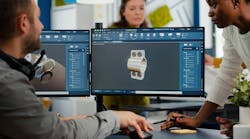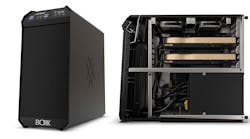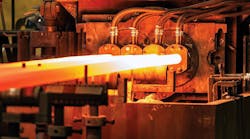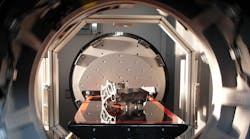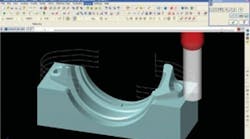Victaulic manufactures and supplies mechanical pipe joining products worldwide, including grooved pipefittings and fluid movement systems. The products are manufactured at ductile iron foundries in Easton, PA, Dalian, China, and Drezdenko, Poland. Victaulic also operates a nonferrous foundry in Richmond Hill, ON. However, for faster and more efficient product delivery, new product prototyping and tooling development for cast-product manufacturing is done at facilities in Pennsylvania’s Lehigh Valley. This allows Victaulic to control the quality of its expanding product line — at the same time that it reduces time to market.
Victaulic was one of the first metalcasters to move from tracers and hardwood master patterns to precision-machined steel tooling for its casting production. That happened when the company purchased an early, wire-frame version of Mastercam from CNC Software Inc. in 1987. Today, between its Tech Center in Allentown, PA, and R&D and manufacturing at corporate headquarters in Easton, PA, Victaulic has 10 seats of the CAD/CAM software that are shared with several more machinists via floating licenses.
Early adopters — The idea behind the Victaulic product line goes back nearly 100 years, to World War I. The Allied armies needed a way to pipe fuel and water to troops in the field more speedily, and installing conventional plumbing that used threaded pipes and welding was simply too slow. The Victory Pipe Joint Co., as it was called then, worked with the British Defence Ministry to develop a concept for joining pipes mechanically, without leakage. It relied on special, bolt-on mechanical couplings that quickly engaged with grooves in the pipe ends and sealed with a gasket.
In 1925, “Victory” and “Hydraulics” were combined to form the name Victaulic Company, which was established in New York. Since then, Victaulic has continued to develop designs and products that solve fluid and air handling problems across a range of industries, including HVAC, plumbing, fire protection, water and waste treatment, oilfield operations, mining, power generation, and manufacturing. These solutions reduce installation times and total installed cost compared to conventional methods that rely on welding, threading, or flanging.
True to its origins Victaulic’s Tech Center adopted CAD/CAM in 1987, purchasing one of the very first Mastercam versions that had only wire-frame representations of the part model. “The Tech Center business plan evolved from the foundry group and succeeded because we embraced the new CAM technology,” according to Bill Nagle, operations supervisor at the Victaulic Tech Center in Allentown, PA. Victaulic had the confidence to jump into machine programming early because of the support available at the Lehigh Career and Technical Institute (LCTI).
“They had 10 seats of Mastercam at the time along with two loaner seats,” recalled Nagle. “One of their instructors at the time, Rich Bosse, was an innovator himself. He merged the software package into his own computerized teaching tool that allowed students to learn computer-aided manufacturing in a fail-safe manner (without exposing themselves or the equipment to danger.) Today, that program is part of a Haas Technical Education Center, which contributes many skilled machinists and programmers to companies in the area every year.”
The 3D manufacturing that Victaulic was doing at that time was considered to be cutting edge. Soon, the company was getting its technical support directly from CNC Software, which partnered with Victaulic to develop manufacturing approaches to tooling design, surface blending, and manufacturing productivity. “As a manufacturer of cast hydraulic components we were soon pushing the 3D envelope of what was possible at the time with our applications,” recalled Walter Sloyer, manager, Engineering Technology for Victaulic. “The software company took an interest in us. They actually asked us what we do best, what we do poorly, and what we would like to do better.”
“Today, the Mastercam intuitive graphical interface is helping us to keep pace with aggressive prototyping and pattern manufacturing operations,” he continued, “and their high-speed toolpaths are allowing us to dramatically reduce machine cycles, secondary operations, and tool costs.”
Speed of innovation — Victaulic reached a milestone when CNC Software launched Mastercam X, a version that allows users to locate all the tools they use most frequently on their computer desktops. This reinforced Victaulic’s preference to use production-ready prototypes for concept proofs as often as possible, allowing it to bring products to market faster than its competitors, and guaranteeing the integrity of the prototype design.
Dave McMurtrie, lab technician and machinist at Victaulic corporate headquarters, commented on why it is important to have CAD software that is fast, intuitive, and creative: “In the R&D shop, the individuality of the machinist and designers contributes to a better product. Each of us has a different viewpoint and may do things differently. We want to be innovative and take in as much input as we can process from various people.
“Ideas are fleeting,” he said. “You think of something, and the faster we can document it and do something with it, the better it will stick. That’s why we emphasize the speed of innovation.”
R&D activities face strict deadlines at Victaulic, and programmers and machinists have been working extended hours for almost a year. They divide their time between machining parts, writing part programs, and discussing manufacturing approaches and part modifications with the design engineers. Their projects arrive as SolidWorks files, and simple parts are programmed directly in the R&D lab.
Lean patternmaking
About 20 miles away from corporate headquarters, another lean Victaulic manufacturing operation, the Tech Center, is running full speed to manufacture the tooling that will be used to make for castings for grooved pipe joining products. Being able to program toolpaths in an intuitive CAM environment is essential to keeping the work flowing. Further, the pattern shop is becoming increasingly reliant on high-speed toolpaths to reduce machine cycles and tool wear. Operations supervisor Bill Nagle estimated that run times with high-speed machining have been reduced by 60% , while tools are lasting at least 25% longer.
Recently the pattern shop has advanced its productivity further with the addition of its own high-speed, five-axis machining center — an Okuma NB56V with Supernurbs (on-board NURBS interpolation). NURB is an acronym for “non-uniform rational B-splines”: These are mathematical instructions in the software that allow Mastercam to call out the smooth curves and surfaces that impact surface finish. On-board NURB interpolation takes execution of these instructions out of the postprocessor and puts them into the controller’s firmware, so they can be executed at much higher speeds.
Nagle said this marriage of hardware and software has allowed Jerry Miley, Tech Center CNC programmer, to conquer complex geometries, eliminate multiple set-ups, reduce machine cycles, and use advanced coatings to improve tool performance, wear, and improve surface finish, dramatically. Manual grinding and polishing has been reduced by as much as 90%.
Production-ready tooling — Cast prototypes are manufactured in the production area. Jerry Miley, Tech Center CNC programmer said, “We’re prototyping with a product that is actually coming out of our production process. This gets us to the closest representation of the real deal for the engineers, providing credible testing results. When it comes time to make tooling, these designs are production-ready.”
In spite of the heavy workload, CAM allows the prototypers to keep pace with an aggressive R&D schedule, and it is allowing the patternmakers to keep pace producing tools that support a vast range of part numbers. There are just four machinists at the Victaulic Tech Center, but they are making production tooling for Victaulic foundries around the world.



